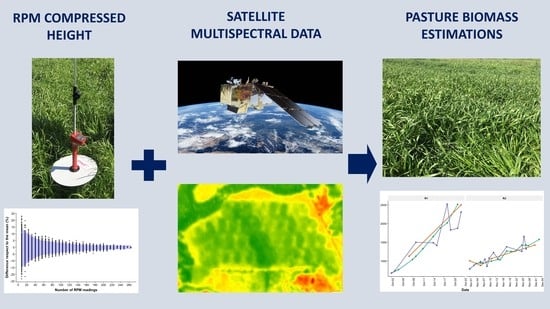Spatial and Temporal Pasture Biomass Estimation Integrating Electronic Plate Meter, Planet CubeSats and Sentinel-2 Satellite Data
Abstract
:1. Introduction
2. Materials and Methods
2.1. Experimental Design
2.2. Data Collection and Management
2.2.1. Rising Plate Meter
2.2.2. Satellite Images
2.3. Data Collation and Processing
2.3.1. RPM and Satellite Calibrations
2.3.2. Minimum Number of RPM Readings
2.3.3. Walking Pattern Analysis
2.3.4. Calibration Methodology Comparison
2.4. Statistical Analysis
3. Results
3.1. Calibration Equations
3.2. Minimum Number of RPM Readings
3.3. Walking Pattern
3.4. Pasture Biomass Estimations
3.5. Calibration Methodology Comparison
4. Discussion
5. Conclusions
Author Contributions
Funding
Acknowledgments
Conflicts of Interest
References
- Dairy Australia. Dairy Farm Monitor Project. Available online: https://www.dairyaustralia.com.au/farm/farm-business-management/dairy-farm-monitor-project (accessed on 17 April 2020).
- Hanrahan, L.; McHugh, N.; Hennessy, T.; Moran, B.; Kearney, R.; Wallace, M.; Shalloo, L. Factors associated with profitability in pasture-based systems of milk production. J. Dairy Sci. 2018, 101, 5474–5485. [Google Scholar] [CrossRef] [PubMed] [Green Version]
- Neal, M.; Dela Rue, B.; Eastwood, C. Defining the value proposition for using technology to improve pasture management and harvest more pasture. In Proceedings of the 7th International Tri-Conference for Precision Agriculture, Hamilton, New Zealand, 16–18 October 2017. [Google Scholar]
- Clark, C.; Farina, S.; Garcia, S.; Islam, M.; Kerrisk, K.; Fulkerson, W. A comparison of conventional and automatic milking system pasture utilization and pre- and post-grazing pasture mass. Grass Forage Sci. 2016, 71, 153–159. [Google Scholar] [CrossRef]
- Clark, C.E.F.; Romera, A.J.; Macdonald, K.A.; Clark, D.A. Inter-paddock annual dry matter yield variability for dairy farms in the Waikato region of New Zealand. N. Z. J. Agric. Res. 2010, 53, 187–191. [Google Scholar] [CrossRef]
- Gargiulo, J.I.; Lyons, N.A.; Kempton, K.; Armstrong, D.A.; Garcia, S.C. Physical and economic comparison of pasture-based automatic and conventional milking systems. J. Dairy Sci. 2020, 103. [Google Scholar] [CrossRef] [PubMed]
- Fulkerson, W.J.; McKean, K.; Nandra, K.S.; Barchia, I.M. Benefits of accurately allocating feed on a daily basis to dairy cows grazing pasture. Aust. J. Exp. Agric. 2005, 45, 331–336. [Google Scholar] [CrossRef]
- Gargiulo, J.I.; Eastwood, C.R.; Garcia, S.C.; Lyons, N.A. Dairy farmers with larger herd sizes adopt more precision dairy technologies. J. Dairy Sci. 2018, 101, 5466–5473. [Google Scholar] [CrossRef]
- Hall, A.; Turner, L.; Irvine, L.; Kilpatrick, S. Pasture management and extension on Tasmanian dairy farms-who measures up? Rural Ext. Innov. Syst. J. 2017, 13, 32. [Google Scholar]
- Eastwood, C.; Mata, G.; Handcock, R.; Kenny, S. Evaluating satellite-based pasture measurement for Australian dairy farmers. In Proceedings of the Joint International Agricultural Conference, Wageningen, The Netherlands, 6–8 July 2009. [Google Scholar]
- García, S.C.; Holmes, C.W. Seasonality of calving in pasture-based dairy systems: Its effects on herbage production, utilisation and dry matter intake. Aust. J. Exp. Agric. 2005, 45, 1–9. [Google Scholar] [CrossRef]
- García, S.C. Systems, Component, and Modelling Studies of Pasture-Based Dairy Systems in Which the Cows Calve at Different Times of the Year. Ph.D. Thesis, Massey University, Palmerston North, New Zealand, 2000. [Google Scholar]
- Lile, J.; Blackwell, M.; Thomson, N.; Penno, J.; Macdonald, K.; Nicholas, P.; Lancaster, J.; Coulter, M. Practical use of the rising plate meter (RPM) on New Zealand Dairy Farms. Proc. N. Z. Grassl. Assoc. 2001, 63, 159–164. [Google Scholar] [CrossRef]
- Thomson, N.; McCallum, D.; Howse, S.; Holmes, C.; Matthews, P.; Matthew, C. Estimation of dairy pastures-the need for standardisation. N. Z. Grassl. Assoc. 1997, 59, 221–226. [Google Scholar] [CrossRef]
- French, P.; O’Brien, B.; Shalloo, L. Development and adoption of new technologies to increase the efficiency and sustainability of pasture-based systems. Anim. Prod. Sci. 2015, 55, 931–935. [Google Scholar] [CrossRef]
- Punalekar, S.M.; Verhoef, A.; Quaife, T.L.; Humphries, D.; Bermingham, L.; Reynolds, C.K. Application of Sentinel-2A data for pasture biomass monitoring using a physically based radiative transfer model. Remote Sens. Environ. 2018, 218, 207–220. [Google Scholar] [CrossRef]
- Ali, I.; Cawkwell, F.; Dwyer, E.; Barrett, B.; Green, S. Satellite remote sensing of grasslands: From observation to management. J. Plant Ecol. 2016, 9, 649–671. [Google Scholar] [CrossRef] [Green Version]
- Edirisinghe, A.; Hill, M.; Donald, G.; Hyder, M. Quantitative mapping of pasture biomass using satellite imagery. Int. J. Remote Sens. 2011, 32, 2699–2724. [Google Scholar] [CrossRef]
- Mata, G.; Clark, D.; Edirisinghe, A.; Waugh, D.; Minneé, E.; Gherardi, S. Predicting accurate paddock-average pasture cover in Waikato dairy farms using satellite images. N. Z. Grassl. Assoc. 2007, 69, 23. [Google Scholar] [CrossRef]
- Hill, M.J.; Donald, G.E.; Hyder, M.W.; Smith, R.C.G. Estimation of pasture growth rate in the south west of Western Australia from AVHRR NDVI and climate data. Remote Sens. Environ. 2004, 93, 528–545. [Google Scholar] [CrossRef]
- Eastwood, C.; Kenny, S. Art or science?: Heuristic versus data driven grazing management on dairy farms. Ext. Farming Syst. J. 2009, 5, 95. [Google Scholar]
- Asher, M.; Raedts, P.; Harrison, M.; Hills, J.; Rawnsley, R. Estimating pasture biomass with Planet Labs CubeSats. In Proceedings of the 2018 Australasian Dairy Science Symposium, Palmerston North, New Zealand, 21–23 November 2018; pp. 196–198. [Google Scholar]
- Anderson, G.P.; Rawlings, M.; Lunniss, Z.; McNAUGHTON, L.; Rossi, L.; Wims, C.; Roach, C.; Ludemann, C.I. Use of pasture botanical composition data on the accuracy of satellite pasture biomass estimates. J. N. Z. Grassl. 2019, 81, 249–254. [Google Scholar] [CrossRef]
- Romera, A.; Beukes, P.; Clark, D.; Clark, C.; Tait, A. Pasture growth model to assist management on dairy farms: Testing the concept with farmers. Grassl. Sci. 2013, 59, 20–29. [Google Scholar] [CrossRef]
- MLA. Real Time Measurement of Pasture Quantity. Available online: https://www.mla.com.au/research-and-development/search-rd-reports/final-report-details/Real-time-measurement-of-pasture-quantity/3647 (accessed on 5 May 2020).
- Schaefer, M.T.; Lamb, D.W. A combination of plant NDVI and LiDAR measurements improve the estimation of pasture biomass in tall fescue (Festuca arundinacea var. Fletcher). Remote Sens. 2016, 8, 109. [Google Scholar] [CrossRef] [Green Version]
- Dabove, P.; Di Pietra, V.; Piras, M. GNSS Positioning Using Mobile Devices with the Android Operating System. ISPRS Int. J. Geo-Inf. 2020, 9, 220. [Google Scholar] [CrossRef] [Green Version]
- ESA. Sentinel-2 Program. Available online: https://sentinel.esa.int/web/sentinel/missions/sentinel-2 (accessed on 27 March 2020).
- Planet Team. Planet Application Program Interface: In Space for Life on Earth. San Francisco, CA. Available online: https://api.planet.com (accessed on 5 March 2020).
- Tucker, C.J. Red and photographic infrared linear combinations for monitoring vegetation. Remote Sens. Environ. 1979, 8, 127–150. [Google Scholar] [CrossRef] [Green Version]
- Garcia, S.C.; Fulkerson, W.J.; Brookes, S.U. Dry matter production, nutritive value and efficiency of nutrient utilization of a complementary forage rotation compared to a grass pasture system. Grass Forage Sci. 2008, 63, 284–300. [Google Scholar] [CrossRef]
- Jenquip. Handbook EC10 Platemeter. Available online: https://www.jenquip.nz/wp-content/uploads/2019/05/Handbook-EC10-Generic-web-.pdf (accessed on 19 June 2020).
- Thomson, N.A.; Blackwell, M. The new pasture assessment model. Proc. South Isl. Dairy Event 1999, 1, 60–67. [Google Scholar]
- Insua, J.R.; Utsumi, S.A.; Basso, B. Estimation of spatial and temporal variability of pasture growth and digestibility in grazing rotations coupling unmanned aerial vehicle (UAV) with crop simulation models. PLoS ONE 2019, 14, e0212773. [Google Scholar] [CrossRef] [PubMed] [Green Version]
- Cleveland, W.S. Robust locally weighted regression and smoothing scatterplots. J. Am. Stat. Assoc. 1979, 74, 829–836. [Google Scholar] [CrossRef]
- Dairy Australia. In Focus 2019: The Australian Dairy Industry. Available online: https://www.dairyaustralia.com.au/-/media/dairyaustralia/documents/about-dairy-australia/key-publications/infocus-2019_final.pdf?la=en&hash=2E3AC335EB665671468CDC7EA557BD0DDFBDA067 (accessed on 5 May 2020).
- Epiphanio, J.N.; Huete, A.R. Dependence of NDVI and SAVI on sun/sensor geometry and its effect on fAPAR relationships in Alfalfa. Remote Sens. Environ. 1995, 51, 351–360. [Google Scholar] [CrossRef]
- Vajsová, B.; Fasbender, D.; Wirnhardt, C.; Lemajic, S.; Devos, W. Assessing Spatial Limits of Sentinel-2 Data on Arable Crops in the Context of Checks by Monitoring. Remote Sens. 2020, 12, 2195. [Google Scholar]
- Gašparović, M.; Medak, D.; Pilaš, I.; Jurjević, L.; Balenović, I. Fusion of Sentinel-2 and PlanetScope Imagery for Vegetation Detection and Monitorin. In Proceedings of the Volumes ISPRS TC I Mid-term Symposium Innovative Sensing-From Sensors to Methods and Applications, Karlsruhe, Germany, 10–12 October 2018. [Google Scholar]
- Sonobe, R. Combining ASNARO-2 XSAR HH and Sentinel-1 C-SAR VH/VV polarization data for improved crop mapping. Remote Sens. 2019, 11, 1920. [Google Scholar] [CrossRef] [Green Version]
- von Bueren, S.K.; Burkart, A.; Hueni, A.; Rascher, U.; Tuohy, M.P.; Yule, I. Deploying four optical UAV-based sensors over grassland: Challenges and limitations. Biogeosciences 2015, 12, 163–175. [Google Scholar] [CrossRef] [Green Version]
- Karunaratne, S.; Thomson, A.; Morse-McNabb, E.; Wijesingha, J.; Stayches, D.; Copland, A.; Jacobs, J. The Fusion of Spectral and Structural Datasets Derived from an Airborne Multispectral Sensor for Estimation of Pasture Dry Matter Yield at Paddock Scale with Time. Remote Sens. 2020, 12, 2017. [Google Scholar] [CrossRef]
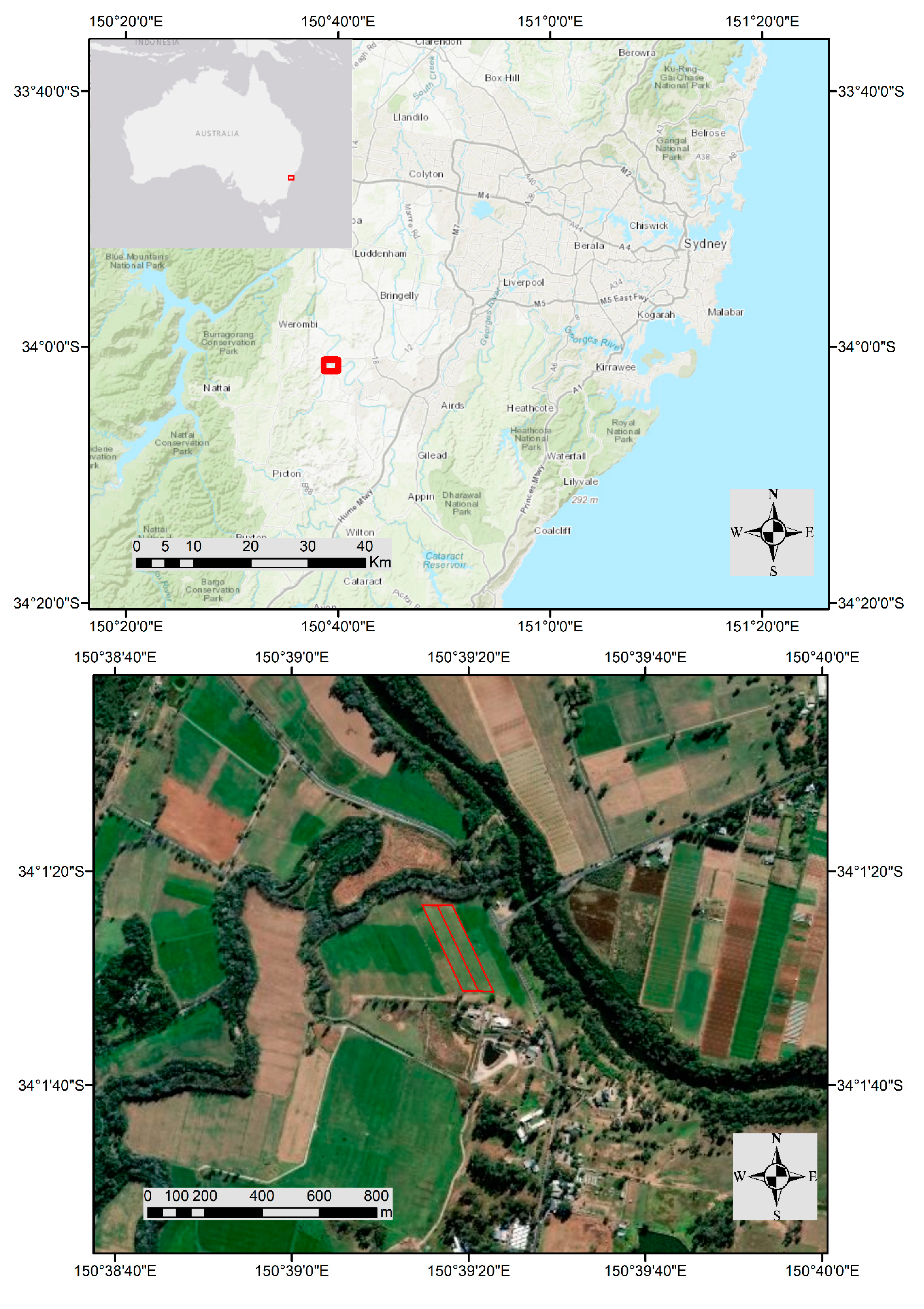

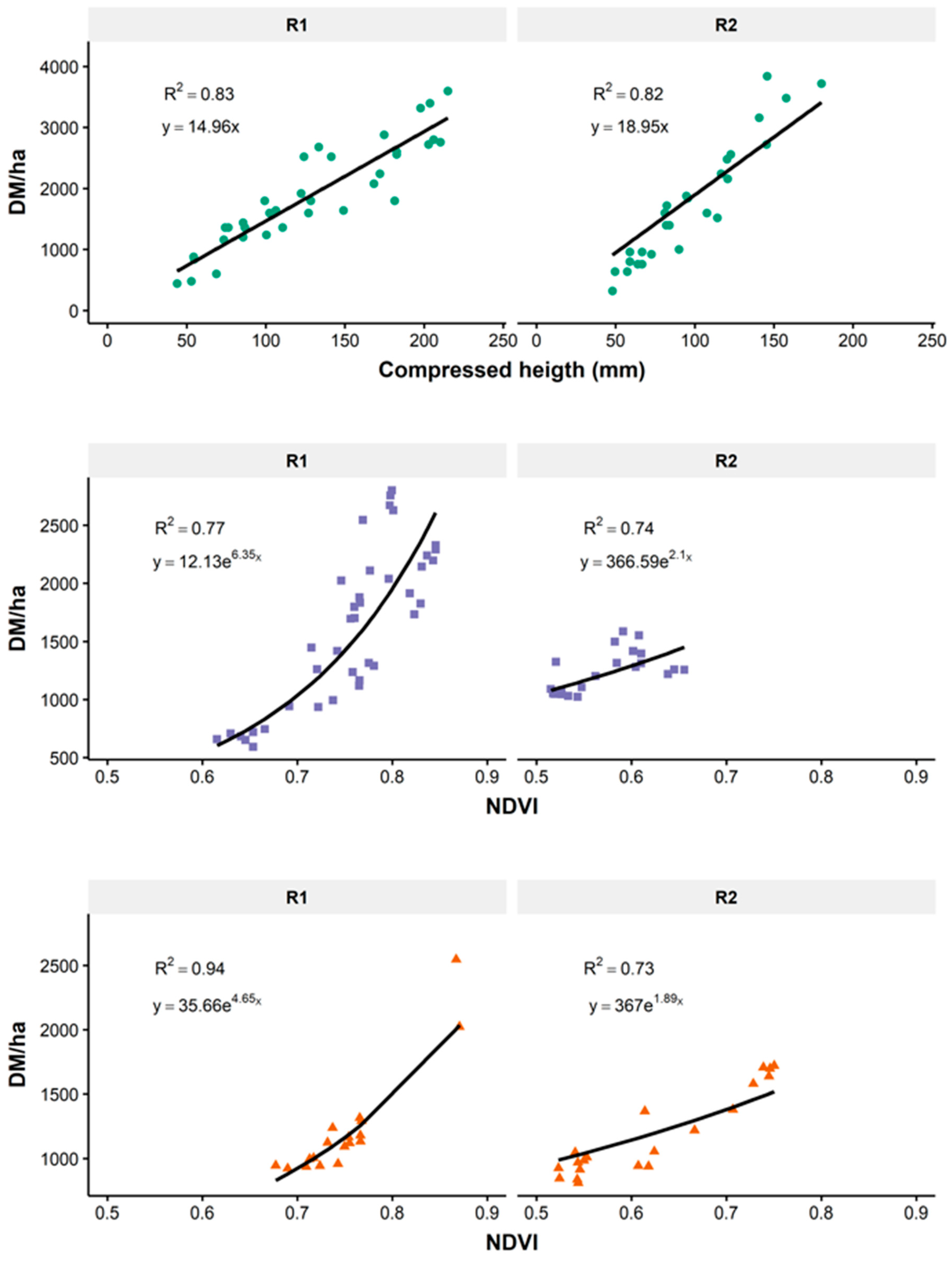
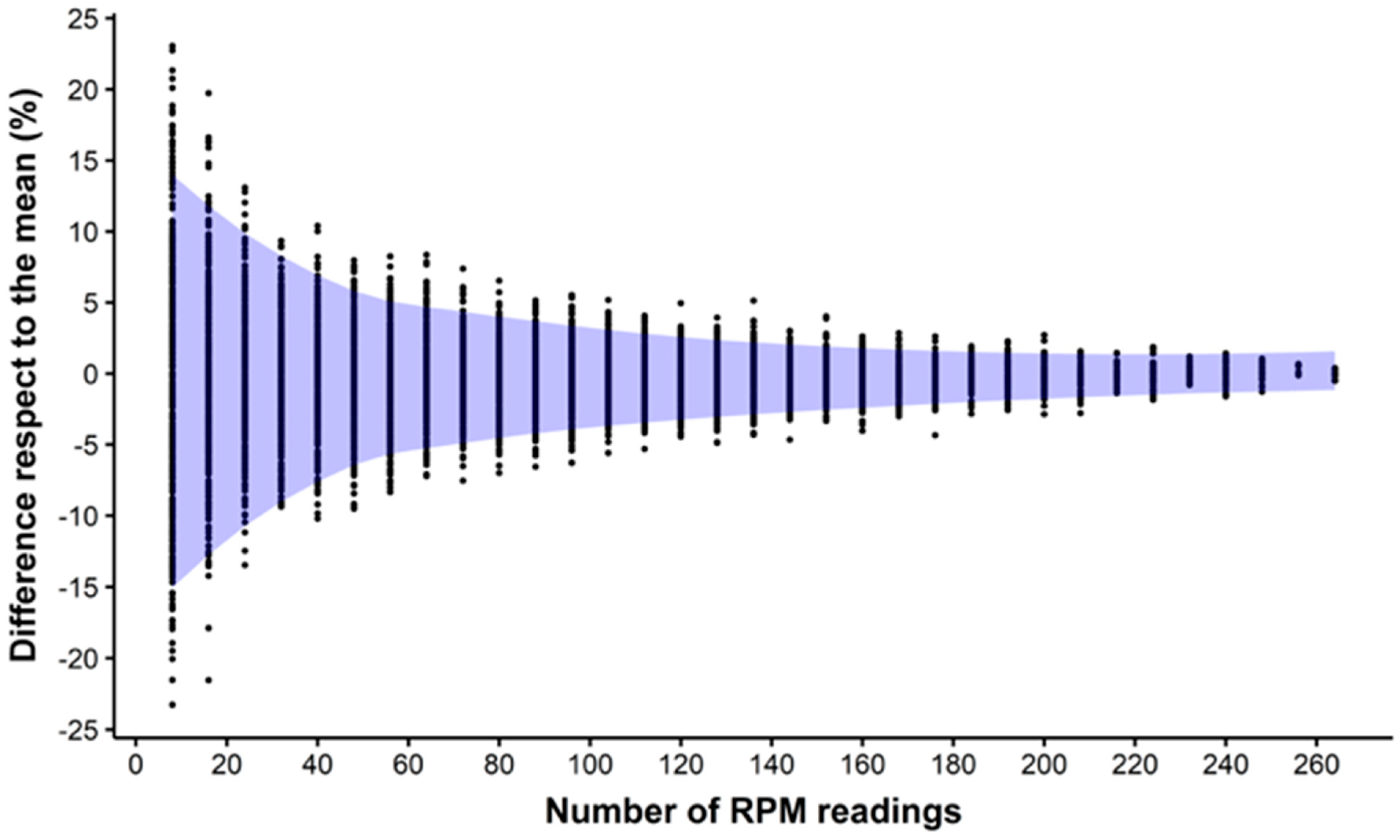
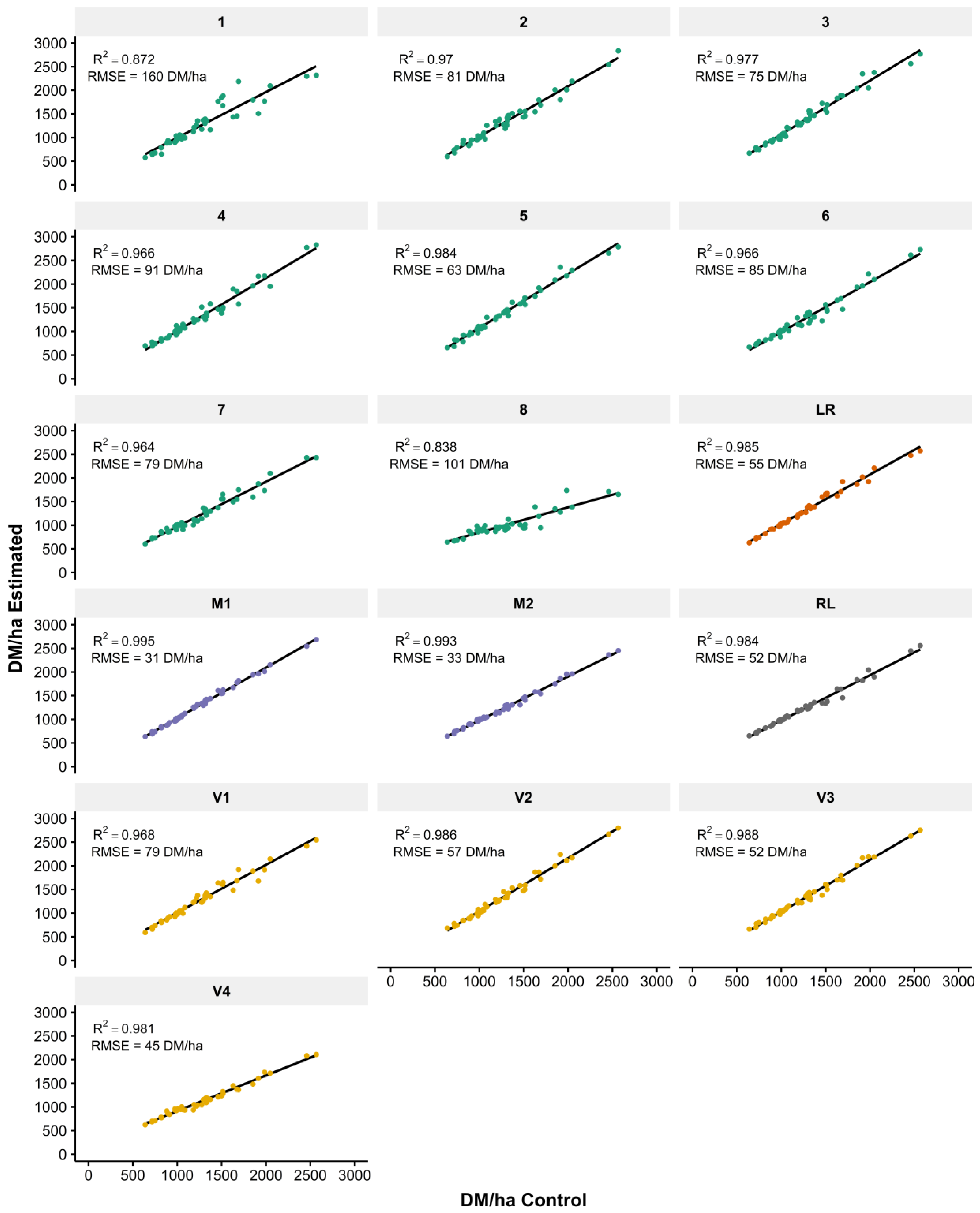

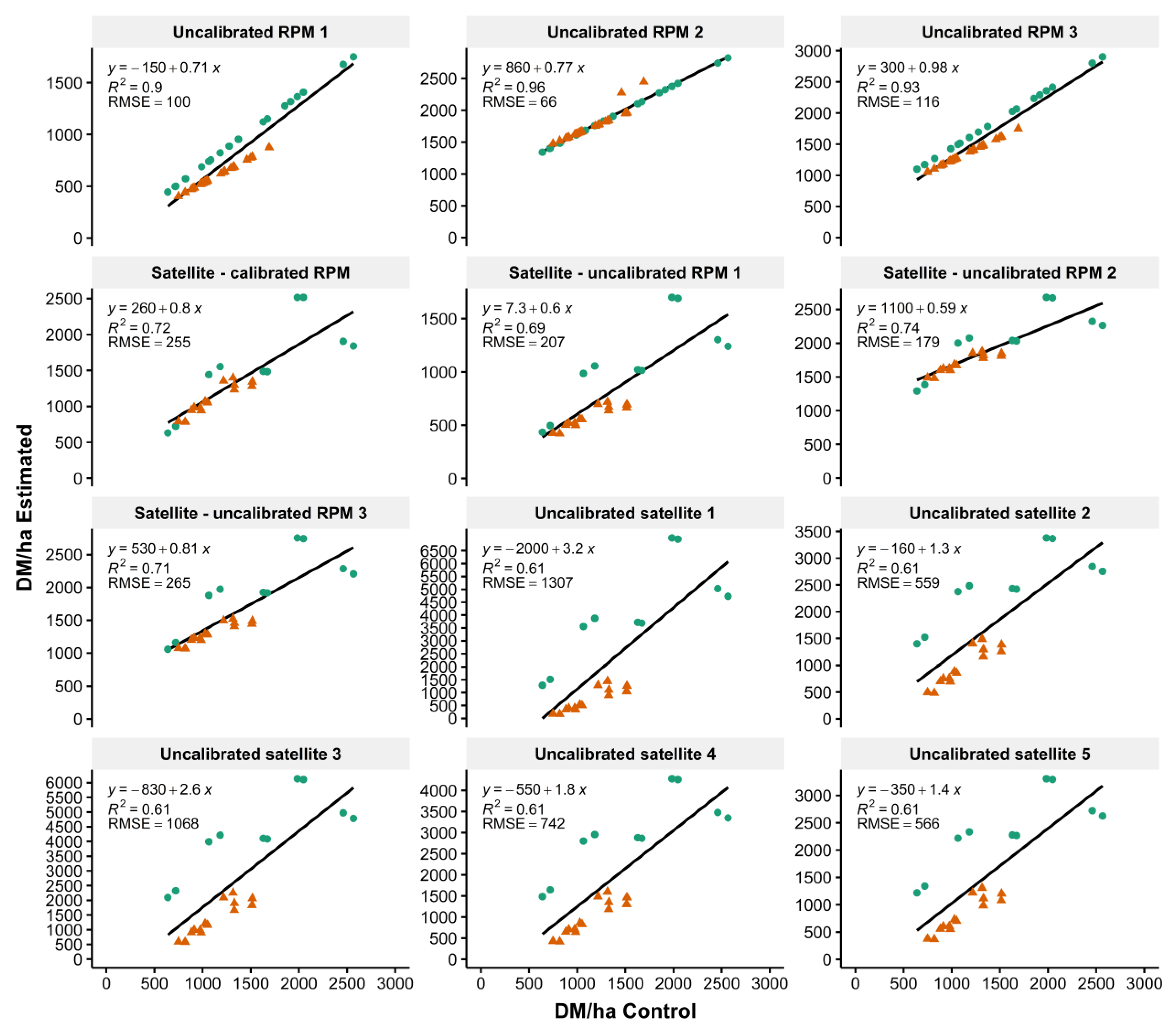
| Images | R1 | R2 | ||
|---|---|---|---|---|
| Sentinel-2 | Planet | Sentinel-2 | Planet | |
| Available | 4 | 11 | 6 | 20 |
| High cloud cover | 2 | 2 | 2 | 7 |
| Utilized | 2 | 9 | 4 | 13 |
| Month | Day | RPM | ||
|---|---|---|---|---|
| Daily 1 | Monthly 2 | Annual 3 | ||
| October | 1–13 | |||
| 14–20 | ||||
| 21–31 | ||||
| November | 1–3 | |||
| 4–10 | ||||
| 11–17 | ||||
| 18–24 | ||||
| 25–30 | ||||
| December | 1–8 | |||
| 9–15 | ||||
| 16–22 | ||||
| 23–30 | ||||
| 31 | ||||
| Item | Equation |
|---|---|
| Uncalibrated satellite 1 | |
| Uncalibrated satellite 2 | |
| Uncalibrated satellite 3 | |
| Uncalibrated satellite 4 | |
| Uncalibrated satellite 5 |
© 2020 by the authors. Licensee MDPI, Basel, Switzerland. This article is an open access article distributed under the terms and conditions of the Creative Commons Attribution (CC BY) license (http://creativecommons.org/licenses/by/4.0/).
Share and Cite
Gargiulo, J.; Clark, C.; Lyons, N.; de Veyrac, G.; Beale, P.; Garcia, S. Spatial and Temporal Pasture Biomass Estimation Integrating Electronic Plate Meter, Planet CubeSats and Sentinel-2 Satellite Data. Remote Sens. 2020, 12, 3222. https://doi.org/10.3390/rs12193222
Gargiulo J, Clark C, Lyons N, de Veyrac G, Beale P, Garcia S. Spatial and Temporal Pasture Biomass Estimation Integrating Electronic Plate Meter, Planet CubeSats and Sentinel-2 Satellite Data. Remote Sensing. 2020; 12(19):3222. https://doi.org/10.3390/rs12193222
Chicago/Turabian StyleGargiulo, Juan, Cameron Clark, Nicolas Lyons, Gaspard de Veyrac, Peter Beale, and Sergio Garcia. 2020. "Spatial and Temporal Pasture Biomass Estimation Integrating Electronic Plate Meter, Planet CubeSats and Sentinel-2 Satellite Data" Remote Sensing 12, no. 19: 3222. https://doi.org/10.3390/rs12193222
APA StyleGargiulo, J., Clark, C., Lyons, N., de Veyrac, G., Beale, P., & Garcia, S. (2020). Spatial and Temporal Pasture Biomass Estimation Integrating Electronic Plate Meter, Planet CubeSats and Sentinel-2 Satellite Data. Remote Sensing, 12(19), 3222. https://doi.org/10.3390/rs12193222





